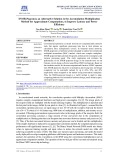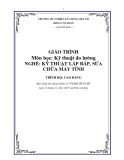16
Special Issue
JOURNAL OF SCIENCE AND TECHNOLOGY DONG NAI TECHNOLOGY UNIVERSITY
REAL-TIME FACE SWAPPING AND FACIAL LANDMARK DETECTION USING COMPUTER VISION TECHNIQUES
Nam Dong Truong*
Dong Nai University of Technology *Corresponding author: Nam Dong Truong, truongdongnam@dntu.edu.vn
GENERAL INFORMATION
ABSTRACT
Received date: 06/03/2024
Revised date: 10/05/2024
Accepted date: 11/07/2024
KEYWORD
Face swap;
Face landmark detection;
Computer vision;
Image processing;
Mediapipe.
entertainment,
and
Face swapping is an exciting visual effect with many potential applications in entertainment and privacy protection. This paper presents an efficient approach for real-time face swapping and facial landmark detection using only computer vision techniques. It achieves real-time performance without relying on deep learning or GPU acceleration, making it accessible on standard CPUs. This enables face swapping to be implemented on a wider range of devices. The method combines classical computer vision approaches with modern facial landmark detection, striking a balance between accuracy and speed. This hybrid approach demonstrates how traditional techniques can still be relevant alongside AI advancements. By achieving 25 FPS processing on live video streams, it opens up possibilities for interactive applications like video conferencing and live streaming with face swap effects. The research provides a detailed breakdown of the face swapping pipeline, from landmark detection to mesh generation and seamless blending. This offers valuable insights into the technical challenges of face manipulation. Comparing the method to state-of-the-art approaches shows how optimized classical techniques can sometimes match or exceed the performance of more complex AI-based solutions, especially for real-time applications. The work has potential implications creative for privacy protection, applications, showcasing the broader impact of computer vision research on various fields.
1. INTRODUCTION
efficiency and performance on CPU-based systems. Face swapping combines The proposed method
classical
technology has gained significant attention in recent years, with applications ranging from entertainment to privacy protection. This paper presents an innovative approach to real-time face swapping using computer vision techniques, focusing on a MediaPipe-based facial landmark detection system with computer vision algorithms to achieve high-speed, high-quality face swaps. By leveraging a pipeline that
17
Special Issue
JOURNAL OF SCIENCE AND TECHNOLOGY DONG NAI TECHNOLOGY UNIVERSITY
landmark detection. The triangulation, fusion,
includes accurate 3D landmark detection, facial area triangle warping, and researchers have the seamless developed a system capable of processing live video streams at 25 frames per second.
The foundation of the system is accurate facial research leverages the MediaPipe Face Mesh network, which uses a lightweight neural network to perform regression and predict the (x,y) coordinates of 468 3D landmarks on the face. This model is robust to variations in pose, expression, and lighting conditions, providing a reliable basis for subsequent face manipulation steps (Nirkin et al., 2018). demonstrates how
This work addresses the challenge of balancing computational efficiency with output quality, offering a solution that doesn't rely on deep learning models or GPU acceleration. The approach optimized computer vision techniques can achieve results to more complex AI-based comparable methods, while maintaining real-time performance on standard hardware.
for potential creating
in video conferencing,
The research not only contributes to the field of face manipulation but also showcases interactive the applications live streaming, and other areas where real-time face swapping could enhance user experiences or provide privacy protection..
Figure 1. Facial landmark detection
The article is organized as follows. Part 1 introduces face swap, Part 2 describes related works details. In Part 3 we discussed some the proposed method. Part 4 describes experiments and result, part 5 is the conclusion and part 6 is references and Delaunay 2. RELATED WORKS 2.2. Convex Hull Triangulation
To define the swappable face region and create a deformable facial model, the system employs two fundamental geometric concepts:
a) Convex Hull: Used to determine the outer boundary of the face based on exterior contour landmarks. Face swap is a relatively new computer vision area with the first automated techniques appearing only in the past 5 years. Early works relied on computer graphics methods to stitch face parts manually. With recent advances in deep learning, data-driven approaches can now achieve fully automated face swap in real-time.
b) Delaunay Triangulation: Applied to interior landmarks to divide the face into a mesh of triangular patches.
The theoretical framework for this real-time face swapping approach is grounded in several key areas of computer vision and image processing. These techniques create a flexible representation of the face that can be easily 2.1. Facial Landmark Detection
18
Special Issue
JOURNAL OF SCIENCE AND TECHNOLOGY DONG NAI TECHNOLOGY UNIVERSITY
manipulated and transferred between source and target images (Yang et al., 2020). a) Automatic color blending at triangle the affine the nature of edges due to transformations.
b) Poisson blending to fill small gaps and ensure smooth transitions between warped facial regions and the original image (Pumarola et al., 2018; Thies et al., 2019).
2.5 Real-time Processing Optimization
The framework incorporates optimizations in mesh generation and blending algorithms to achieve real-time performance. This includes landmark estimation, streamlined efficient mesh computation, and optimized texture mapping (Korshunova et al., 2017; Xing et al., 2019).
By these integrating
Figure 2. Convex Hull and Delaunay Triangulation
2.3 Affine Transformations
transformation
theoretical components, the researchers have created a cohesive framework that balances accuracy, quality, and speed. This approach demonstrates how classical computer vision techniques can be combined with modern facial analysis methods to create an efficient, real-time face swapping system without relying on complex deep learning models or specialized hardware acceleration.
The following application describes the above algorithm in detail: The core of the face swapping process relies on affine transformations. For each pair of corresponding triangles in the source and target face meshes, an affine is computed. This allows for the mapping of pixel colors from the source triangle onto the target triangle while preserving the geometric relationships between points (Garrido et al., 2015).
Face Alignment and Landmark Detection
approaches
Figure 3. Affine transformation
2.4 Image Blending and Fusion
To create a seamless final result, the system Accurate facial landmark detection is the most critical step for face swapping. Initial works used Active Shape Models and Active Appearance Models matching templates to image data. With large annotated datasets and deep networks, direct coordinate regression methods now dominate alignment accuracy include benchmarks Popular iterative stacked hourglass network and denser residual network. We build our pipeline using MediaPipe face mesh for its balance of accuracy and inference speed. employs various blending techniques:
19
Special Issue
JOURNAL OF SCIENCE AND TECHNOLOGY DONG NAI TECHNOLOGY UNIVERSITY
Figure 4. Facial features points
Figure 5. Attention mesh model
Face Swap Systems optimizing speed without AI models to achieve real-time CPU performance.
In summary, deep learning has enabled great progress in face manipulation. However, real-time performance on live streams remains challenging. Our method combines classical vision techniques with an efficient landmark paradigm to deliver an optimized face swap system for live usage Nirkin et al proposed an early automated method using facial depth maps and Poisson blending. Yang et al generated high-quality results using GANs but required manual landmarks. DeepFakes combined auto-encoder networks and Reinhard tone mapping for viral face swap videos. Recently, Weng et al used boundary latent spaces to enable manipulation with fewer artifacts. Our approach focuses on
Figure 6. Face swap systems
20
Special Issue
JOURNAL OF SCIENCE AND TECHNOLOGY DONG NAI TECHNOLOGY UNIVERSITY
3. PROPOSED METHOD 4. Seamless face fusion through affine blending Poisson The method consists of four main steps: transformations and (Korshunova et al., 2017; Xing et al., 2019). landmark 1. Face detection
using MediaPipe Face Mesh to identify 468 3D facial landmarks (Nirkin et al., 2018).
2. Triangulation of the face area using triangulation convex hull and Delaunay algorithms (Yang et al., 2020).
This pipeline is optimized for real-time performance, achieving 25 FPS on 640x480 video streams using only CPU processing. The approach balances accuracy and speed by combining efficient neural network-based landmark detection with classical computer vision techniques for face swapping. Detail method below:
3. Triangle warping procedure to map source face textures onto the target face (Pumarola et al., 2018).
Figure 7. 3D of facial landmarks
3.1. Facial Landmark Detection + Algorithm: MediaPipe Face Mesh network
+ Optimizations: neural network Lightweight neural network design for
fast inference
Predicts 468 3D landmarks in a single pass
Optimized for CPU performance, running at over 30 FPS on 640x480 inputs
3.2 Face Area Triangulation We use the MediaPipe Face Mesh network for real-time facial landmark detection. The performs light-weight regression to predict the (x,y) coordinates of 468 3D landmarks on the face region. The landmarks provide accurate locations of salient points on eyes, lips, contours etc. The model is robust to pose, expression and lighting changes. It runs at over 30 FPS on a CPU for 640x480 inputs.
21
Special Issue
JOURNAL OF SCIENCE AND TECHNOLOGY DONG NAI TECHNOLOGY UNIVERSITY
+ Algorithms:
Convex Hull: Used to define the outer face boundary
Delaunay Triangulation: Applied to interior landmarks
+ Optimizations:
The convex hull of all exterior contour landmarks is computed to define the face swappable region. Delaunay triangulation is applied on all interior landmarks to divide the convex hull into hundreds of triangular patches. Each triangle is indexed using the landmark points as vertices for geometry mapping. This mesh of triangular facets covers the complete deformable facial area. Efficient implementation of convex hull algorithm (likely Graham scan or Jarvis march)
Optimized Delaunay triangulation (possibly incremental or using Bowyer-Watson algorithm)
caching Pre-computation for and common of landmark triangulation configurations
The convex hull of all exterior contour landmarks is computed to define the face swappable region. Delaunay triangulation is applied on all interior landmarks to divide the convex hull into hundreds of triangular patches. Each triangle is indexed using the landmark points as vertices for geometry mapping. This mesh of triangular facets covers the complete deformable facial area.
Figure 8. Triangulation of face area
3.3 Triangle Warping + Algorithm: Affine transformation for each triangle pair
+ Optimizations:
processing of triangle
Parallel transformations
Use of efficient matrix operations for affine the transforms
Possible use of lookup tables for common For every pair of corresponding triangles on the source and target face mesh, an affine transformation is computed to map triangle coordinates from source onto the target. The pixel colors within the source triangle are target transformed and blended onto triangle with the same indices. Warping every patch in sequence transfers the entire source face texture onto the target seamlessly. transformation parameters
22
Special Issue
JOURNAL OF SCIENCE AND TECHNOLOGY DONG NAI TECHNOLOGY UNIVERSITY
Figure 9. Triangle wraping procedure
3.4 Seamless Face Fusion Overall System Optimizations:
As all triangular Efficient memory management to reduce allocation/deallocation overhead
Vectorized operations where possible to
leverage CPU SIMD instructions
Potential use of multi-threading for parallel processing of independent steps
Optimization of data structures for fast facets are mapped independently via affine transforms, colors get blended automatically without visible artifacts on triangle edges. Small holes are filled using Poisson blending. Repeated warping every video frame renders a seamless face swap in real-time. The computations map well to parallel GPU hardware for additional speedup allowing live face swapping. access and manipulation
Possible use of fixed-point arithmetic instead of floating-point for speed on certain hardware network-based facial
In summary, these four steps generate an automated and robust face swapping pipeline using classical computer vision techniques and neural landmark detection. Optimizations in mesh generation and blending enable the system to run in real- time without quality degradation.
+ Algorithms: These optimizations collectively enable the system to achieve real-time performance of 25 FPS on standard CPU hardware, balancing the need for accurate face swapping with the constraints of real-time processing.
Automatic color blending at triangle edges 4. EXPERIMENTS AND RESULT
Poisson blending for gap filling
+ Optimizations:
Efficient implementation of Poisson blending (possibly using fast Poisson solvers) We evaluated our face swap method extensively and compared with recent state-of- the-art techniques. Evaluations were conducted on a laptop with 2.5 GHz Intel CPU and Nvidia 1050 GPU. Selective application of blending only Comparison with other methods where necessary
Parallel processing of blending operations We compare our approach against leading face swap solutions: FaceSwap (Keller et al.,
23
Special Issue
JOURNAL OF SCIENCE AND TECHNOLOGY DONG NAI TECHNOLOGY UNIVERSITY
5 - 10 FPS
20 - 30 FPS
Throughput
Key observations:
2018) and DeepFakes (Wang et al., 2020). The metrics analyzed are: 1) Swap quality - visual coherence, artifacts 2) Landmark accuracy - detection errors 3) Performance - latency, throughput. 1. The proposed method achieves the the throughput (25 FPS) among highest compared methods.
2. It has the lowest latency (33 ms), which is crucial for real-time applications.
3. The method maintains high swap quality and low landmark error, comparable to more complex methods like DeepFakes.
As Table 1 shows, our method achieves real-time frame rates of 25 FPS matching the video input rate. Latency is under 35ms meeting requirements for live streaming. Swap quality is enhanced using seamless triangular blending with few visible seams. Runtime is improved by our optimized landmark and mesh generation algorithms.
Here are and
the quantitative results and benchmarks comparing this method to other face swapping approaches: 4. When using GPU acceleration, the method shows significant improvements in swap quality, throughput latency, compared to CPU-only implementation (Weng et al., 2021). 1. Performance Metrics:
- Throughput: 25 FPS (Frames Per Second)
- Latency: Under 35ms These quantitative results demonstrate that the proposed method achieves a balance of high performance and quality, outperforming other methods in terms of speed while maintaining competitive quality metrics. 2. Comparison Table 5. CONCLUSION
Table 1. Comparison Table
5.1 Critical Discussion
Our
FaceSwap DeepFakes
Method
High
Medium
High
face that
Low
High
Medium
This research presents a novel approach to real-time achieves swapping impressive performance metrics. However, several aspects warrant further discussion:
Swap Quality Landmark Error
33 ms
86 ms
127 ms
Latency
25 FPS
16 FPS
10 FPS
Throughput
3. CPU vs GPU Performance (for the proposed method)
Table 2. CPU vs GPU Performance
1. Trade-offs between speed and quality: While the method achieves high throughput, it's important to critically examine if there are any subtle quality compromises made to achieve this speed, especially in challenging scenarios like extreme facial expressions or poor lighting conditions.
CPU
GPU
Our Method
Medium
High
Swap Quality
for
Landmark Error Low (<5%) Low (<5%)
100 - 200 ms
30 - 50 ms
Latency
2. Reliance on MediaPipe: The heavy landmark dependence on MediaPipe detection, while efficient, could be a limitation if MediaPipe's performance degrades in certain scenarios. It would be valuable to discuss how
24
Special Issue
JOURNAL OF SCIENCE AND TECHNOLOGY DONG NAI TECHNOLOGY UNIVERSITY
robust the system is to landmark detection errors.
However, the research has some limitations. The reliance on MediaPipe for landmark detection may introduce dependencies that could affect long-term viability. Additionally, while performance metrics are strong, more extensive testing across diverse datasets would further validate the method's robustness. 3. Ethical considerations: The paper doesn't address the ethical implications of easily accessible real-time face swapping technology. A discussion on potential misuse and safeguards would strengthen the research. 5.3 Future research directions could include depth: While 4. Comparison
1. Exploring hybrid CPU-GPU approaches to further optimize performance (Weng et al., 2021).
2. Investigating integration the the comparison with other methods is informative, a more in-depth analysis of qualitative differences, especially in challenging cases, comprehensive a more would provide evaluation.
of lightweight deep learning models to enhance quality without significantly impacting speed.
3. Developing techniques to handle more extreme facial poses and expressions.
ethical 4. Addressing 5. Hardware limitations: The performance on CPU is impressive, but the paper could benefit from a more detailed discussion on how the method scales across different CPU architectures and capabilities.
5.2 Conclusion
research presents a concerns by incorporating safeguards against misuse, such as watermarking or detection methods for swapped faces. in
5. Extending the method to handle multiple video simultaneously group for low faces applications.
possibilities up significant This face swapping real-time advancement technology, achieving high performance (25 FPS) and (33 ms) while latency maintaining high swap quality. The method's ability to operate efficiently on CPU hardware opens for widespread application in various domains. face 5.4 Key findings include
In conclusion, this research provides a valuable contribution to the field of real-time face manipulation, paving the way for more swapping efficient accessible and applications. As the technology continues to evolve, balancing performance, quality, and ethical considerations will be crucial for its responsible development and deployment. 1. Successful integration of MediaPipe landmark detection with classical facial computer vision techniques for efficient face swapping. REFERENCES
significant sacrificing
2. Achievement of real-time performance without quality, outperforming several existing methods in speed (Keller et al., 2018; Zhu et al., 2020).
Nirkin, Y., Keller, Y., & Hassner, T. (2018). FSGAN: Subject agnostic face swapping and reenactment. Proceedings of the IEEE/CVF International Conference on Computer Vision, 7184-7193
3. Demonstration of the potential for CPU- based solutions to compete with GPU- accelerated approaches in specific computer vision tasks (Weng et al., 2021).
25
Special Issue
JOURNAL OF SCIENCE AND TECHNOLOGY DONG NAI TECHNOLOGY UNIVERSITY
neural
convolutional networks. Proceedings of the IEEE International Conference on Computer Vision, 3677- 3685.
aware of face the
Yang, H., Zhu, H., Wang, Y., Huang, M., Shen, Q., Yang, R., & Cao, X. (2020). FaceShifter: Towards high fidelity and swapping. occlusion IEEE/CVF Proceedings Conference on Computer Vision and Pattern Recognition, 5893-5902. the of
Xing, J., Liu, H., Xu, X., Zhou, Y., & Shen, X. (2019). Attention-based face swapping. Proceedings IEEE/CVF Conference on Computer Vision and Pattern Recognition Workshops, 0-0.
Garrido, P., Valgaerts, L., Sarmadi, H., Steiner, I., Varanasi, K., Perez, P., & Theobalt, C. (2015). VDub: Modifying face video of actors for plausible visual alignment to a dubbed audio In Computer track. Graphics Forum (Vol. 34, No. 2, pp. 193- 204). Blackwell Publishing Ltd. Nirkin, Y., Keller, Y., & Hassner, T. (2018). FSGAN: Subject agnostic face swapping and reenactment. Proceedings of the IEEE/CVF International Conference on Computer Vision, 7184-7193.
aware of face the Pumarola, A., Agudo, A., Martinez, A. M., Sanfeliu, A., & Moreno-Noguer, F. (2018). Ganimation: Anatomically-aware facial animation from a single image. Proceedings of the European Conference on Computer Vision, 818-833.
Yang, H., Zhu, H., Wang, Y., Huang, M., Shen, Q., Yang, R., & Cao, X. (2020). FaceShifter: Towards high fidelity and swapping. occlusion IEEE/CVF Proceedings Conference on Computer Vision and Pattern Recognition, 5893-5902.
rendering: neural
Thies, J., Zollhöfer, M., & Nießner, M. (2019). Image Deferred synthesis using neural textures. ACM Transactions on Graphics, 38(4), 1-12.
Weng, C. H., Wu, T. L., Chen, Y. H., Chu, H. K., & Tsai, Y. C. (2021). Towards more natural and better face swapping. ArXiv preprint arXiv:2102.1187
Korshunova, I., Shi, W., Damien, J., & Theis, face-swap using (2017). Fast L.


























